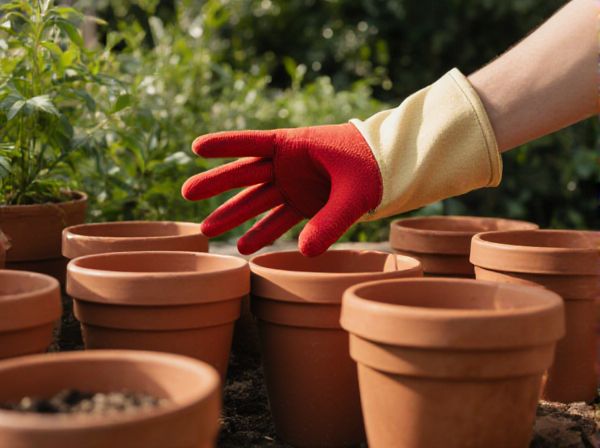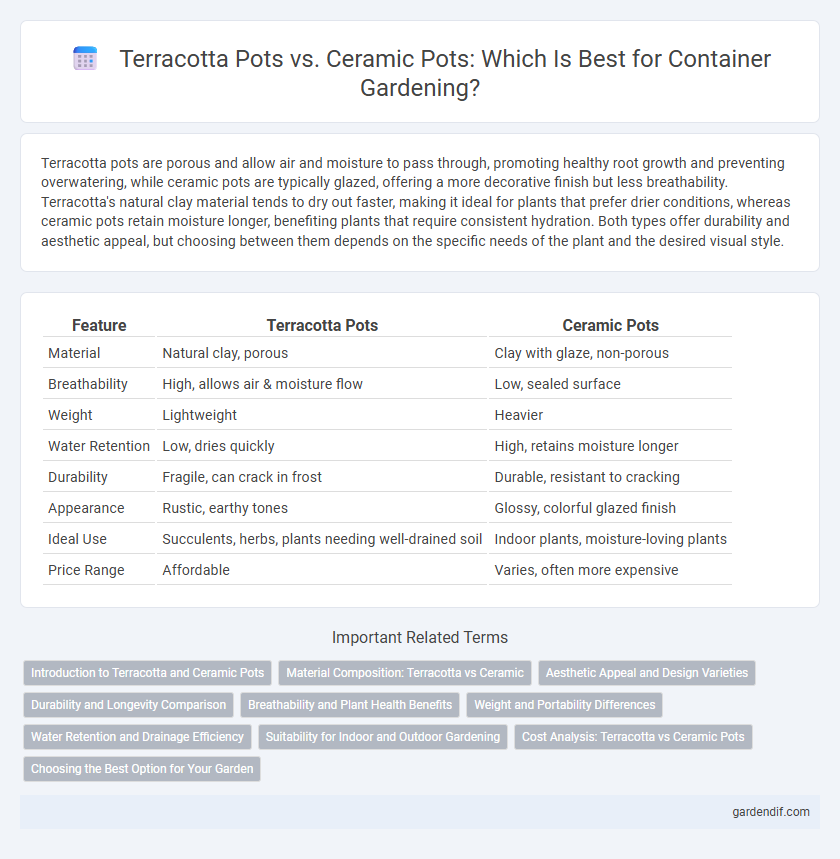
Terracotta pots vs ceramic pots Illustration
Terracotta pots are porous and allow air and moisture to pass through, promoting healthy root growth and preventing overwatering, while ceramic pots are typically glazed, offering a more decorative finish but less breathability. Terracotta's natural clay material tends to dry out faster, making it ideal for plants that prefer drier conditions, whereas ceramic pots retain moisture longer, benefiting plants that require consistent hydration. Both types offer durability and aesthetic appeal, but choosing between them depends on the specific needs of the plant and the desired visual style.
Table of Comparison
| Feature | Terracotta Pots | Ceramic Pots |
|---|---|---|
| Material | Natural clay, porous | Clay with glaze, non-porous |
| Breathability | High, allows air & moisture flow | Low, sealed surface |
| Weight | Lightweight | Heavier |
| Water Retention | Low, dries quickly | High, retains moisture longer |
| Durability | Fragile, can crack in frost | Durable, resistant to cracking |
| Appearance | Rustic, earthy tones | Glossy, colorful glazed finish |
| Ideal Use | Succulents, herbs, plants needing well-drained soil | Indoor plants, moisture-loving plants |
| Price Range | Affordable | Varies, often more expensive |
Introduction to Terracotta and Ceramic Pots
Terracotta pots, made from porous clay fired at low temperatures, offer excellent breathability and moisture regulation for plant roots. Ceramic pots are glazed and fired at higher temperatures, providing a non-porous, decorative, and durable container option. Both types serve distinct horticultural purposes and vary in weight, water retention, and aesthetic appeal.
Material Composition: Terracotta vs Ceramic
Terracotta pots are made from natural clay that is fired at lower temperatures, resulting in a porous material that allows air and moisture to pass through, promoting healthy root growth. Ceramic pots, typically glazed and fired at higher temperatures, have a denser, non-porous surface that retains moisture longer but restricts airflow to the soil. The mineral content and firing process create distinct textures and functional properties, influencing watering needs and plant health for each pot type.
Aesthetic Appeal and Design Varieties
Terracotta pots offer a rustic, earthy aesthetic with warm, natural hues that enhance garden spaces and complement greenery, while ceramic pots provide a wide range of vibrant colors, glossy finishes, and intricate patterns suited for modern and decorative styles. The porous nature of terracotta contributes to a textured, matte look favored in traditional and Mediterranean-style gardens, whereas ceramic pots often feature smooth, polished surfaces that can include detailed craftsmanship and artistic designs. Gardeners seeking a natural, vintage charm lean towards terracotta, whereas those desiring bold, customizable visual statements prefer diverse ceramic styles.
Durability and Longevity Comparison
Terracotta pots are porous and prone to cracking in freezing temperatures, making them less durable in harsh climates compared to ceramic pots. Ceramic pots, made from glazed clay, offer enhanced resistance to weather elements and typically have a longer lifespan due to their non-porous surface. Both materials require proper care, but ceramic pots generally outperform terracotta in durability and longevity for lasting garden containers.
Breathability and Plant Health Benefits
Terracotta pots offer superior breathability due to their porous material, allowing air and moisture to penetrate the walls, which helps prevent root rot and promotes healthier root systems. Ceramic pots, often glazed, limit airflow and moisture exchange, potentially leading to overwatering issues but providing better water retention for plants needing consistent moisture. Choosing terracotta enhances soil aeration and reduces the risk of fungal diseases, making it ideal for plants requiring well-drained conditions.
Weight and Portability Differences
Terracotta pots are generally lighter and more porous, making them easier to move and providing better airflow for roots, while ceramic pots tend to be heavier and denser, offering greater stability but reduced portability. The weight difference is significant; terracotta pots can weigh up to 50% less than similarly sized glazed ceramic pots. For gardeners prioritizing mobility, especially in larger containers, terracotta offers a practical advantage in ease of transport and handling.
Water Retention and Drainage Efficiency
Terracotta pots offer superior water retention due to their porous structure, allowing moisture to evaporate slowly and preventing root rot in plants. Ceramic pots often feature a glazed surface that limits water absorption but may reduce drainage efficiency, increasing the risk of waterlogging. Effective drainage in terracotta containers promotes healthier root systems, while ceramic pots require well-designed drainage holes to balance moisture levels.
Suitability for Indoor and Outdoor Gardening
Terracotta pots, made from natural clay, offer excellent breathability and moisture regulation, making them ideal for outdoor gardening where plants benefit from better air and water flow. Ceramic pots, often glazed, retain moisture longer and provide a decorative finish suited for indoor plants that require consistent watering and controlled environments. Both types accommodate various plant species, but terracotta's porous nature suits drier outdoor settings, while ceramic pots thrive indoors with stable humidity levels.
Cost Analysis: Terracotta vs Ceramic Pots
Terracotta pots typically cost less due to their simpler manufacturing process and use of natural clay, making them an economical choice for gardeners on a budget. Ceramic pots often involve glazing and firing at higher temperatures, increasing production costs and resulting in a higher retail price. Evaluating durability and maintenance expenses reveals that while ceramic pots may have a higher upfront cost, their longer lifespan can offset initial investment compared to the more fragile terracotta options.
Choosing the Best Option for Your Garden
Terracotta pots offer excellent breathability and natural insulation, promoting healthy root growth by allowing air and moisture exchange, while ceramic pots provide a more durable, glazed surface that retains moisture longer and enhances aesthetic appeal with varied designs. The choice depends on your garden's watering needs and climate conditions; terracotta is ideal for plants requiring well-drained soil in hot, dry environments, whereas ceramic pots suit moisture-loving plants in cooler or humid settings. Considering factors like plant species, watering frequency, and outdoor exposure will help determine the optimal container for sustaining plant health and garden beauty.
Terracotta pots vs ceramic pots Infographic

 gardendif.com
gardendif.com